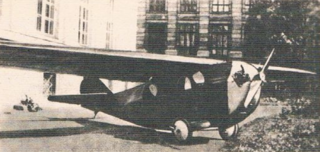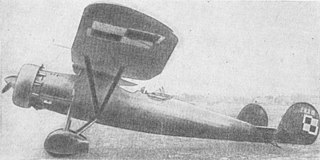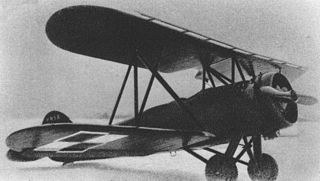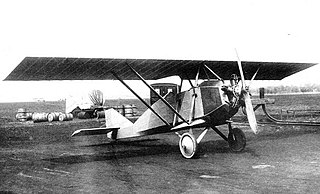
The RWD-14 Czapla was a Polish army cooperation aircraft, designed in the mid-1930s by the RWD team, and produced in the LWS factory from 1938. A series of 65 aircraft were built and most were used by the Polish Air Force observation squadrons during World War II in 1939.

The RWD 1 was a Polish sports plane of 1928, a single-engine high-wing monoplane constructed by the RWD design team.

The RWD-10 was a Polish aerobatics sports plane, single-seat parasol wing monoplane, used from 1933 to 1939 and constructed by the RWD team.

PZL.46 Sum (sheatfish) was a light bomber of the Polish Air Force before World War II, which, was directed to serial production in the spring of 1939. These planes were in production, but the Polish industry did not manage to produce them before the outbreak of the war.

The PZL.38 Wilk (wolf) (PZL-38) was a Polish heavy fighter developed and manufactured by PZL state factory in 1937. Intended for use primarily as a fighter-bomber, the Polish Air Force also envisioned it replacing light fighters in long-range operations, along with being able to serve as a light bomber. Only two examples were built before the project was cancelled in favor of a planned improved variant, the PZL.48 Lampart.

The PWS-33 Wyżeł was a Polish twin-engined military trainer aircraft from a period before World War II constructed by Podlaska Wytwórnia Samolotów or PWS. Although destined for production it got no further than the prototypes before Poland was invaded.

The PWS-10 was a Polish fighter aircraft, constructed in the PWS. It was the first Polish-designed fighter to enter serial production.

The PWS-19 was a Polish reconnaissance and bomber plane prototype of the 1930s, constructed in the PWS.
The PZL.48 Lampart (leopard) was a Polish heavy fighter-bomber design, that remained only a project, owing to the outbreak of World War II.

The Bartel BM 6 was a Polish biplane trainer fighter aircraft of 1930. It did not advance beyond the prototype stage.
The Potez XV was a French single-engine, two-seat observation biplane designed as a private venture by Louis Coroller and built by Potez and under licence by Podlaska Wytwórnia Samolotów and Plage i Laśkiewicz in Poland.

The PWS-20 was a Polish single-engine high-wing 8 passenger airliner, built in the PWS factory and when it made its first flight in 1929 it became the first Polish-designed transport aircraft to fly.

The PWS-1 was a Polish two-seat fighter and reconnaissance aircraft constructed by Podlaska Wytwórnia Samolotów (PWS) in 1927. It remained a prototype for its entire lifespan.

The RWD-16 was a Polish two-seat low-wing sports plane of 1936, constructed by the RWD team, that remained a prototype.

The Lublin R-XII was the Polish three-seat sports and touring aircraft, designed in 1930 in the Plage i Laśkiewicz factory in Lublin, that remained a prototype.

The PWS-5 or PWS-5t2, was a multi-seated Polish liaison aircraft, developed in 1928 by PWS.

The PWS-6, was a Polish liaison aircraft, developed in 1930 by the PWS, that remained a prototype.

The PWS-11 was a Polish aerobatic and trainer aircraft, developed in 1928-1929 by PWS, which remained a prototype.

The PWS 3 was a Polish sport aircraft, developed in 1927 by PWS, which remained a prototype.

The PWS-4 was a prototype Polish sports aircraft, developed in 1928 by Podlaska Wytwórnia Samolotów.


















